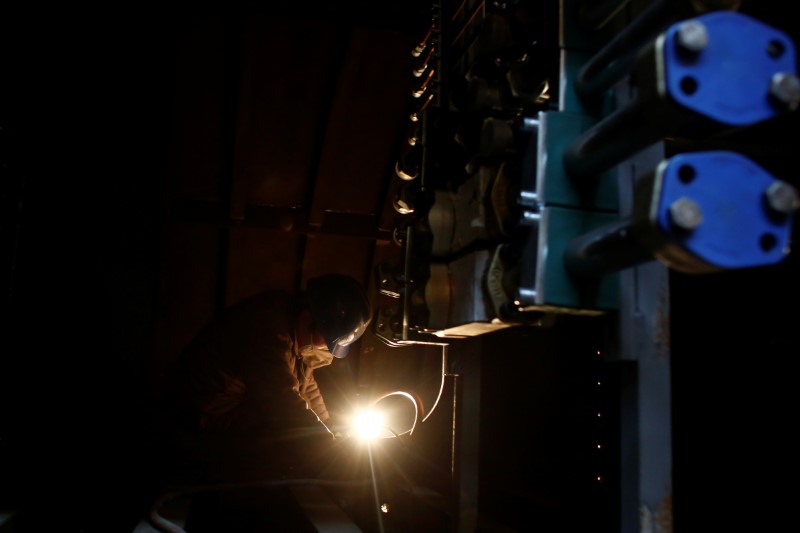By Yawen Chen and Nicholas Heath
BEIJING (Reuters) - Activity in China's manufacturing sector unexpectedly expanded at the fastest pace in nearly 5 years in March, adding to evidence that the world's second-largest economy has gained momentum early this year as construction booms.
But while factory output accelerated and new orders from home and abroad improved, economists are increasingly questioning how long China's solid growth can be sustained.
Over a dozen cities have announced fresh measures in March to cool the overheated property market, while the export outlook is threatened by U.S. President Donald Trump's protectionist rhetoric.
For now, though, China's factories appear to have shifted into higher gear, encouraged by the strongest profit growth in six years.
China's official Purchasing Managers' Index (PMI) rose to 51.8 in March from the previous month's 51.6, data showed on Friday.
That was the strongest reading since April 2012 and well above the 50-point mark that separates growth from contraction on a monthly basis. Economists had expected 51.6.
Manufacturers also stopped shedding jobs in March for the first time in nearly five years as profitability improved. A prolonged slump in the sector and Beijing's recent campaign to cut excess capacity in "smokestack" industries such as steel have put millions out of work.
In an encouraging sign that China's economic growth is also becoming more balanced and broad based, activity in the services sector accelerated last month. The official non-manufacturing Purchasing Managers' Index (PMI) rose to 55.1, the highest since May 2014, a separate survey showed.
The March activity readings and a raft of upbeat data for January and February point to solid growth early in 2017.
China's economy likely expanded 6.8 percent in the first quarter from a year earlier, in line with the previous quarter, said Zhang Yiping, an economist at Merchants Securities. China will release the first-quarter data on April 17.
Analysts polled by Reuters in January had expected growth would start to cool this quarter, and even the government has set a less aggressive full-year growth target of 6.5 percent.
UNSUSTAINABLE GROWTH?
China's better-than-expected performance so far may be largely due to a surprise rebound in home sales and strong government infrastructure investment, which have added fresh impetus to a months-long construction boom that has lifted demand for materials from cement to steel.
Factory output accelerated in March, with the sub-index rising to 54.2 from 53.7 in February. Highlighting the strength of the building boom, a measure of the construction industry stood at a robust 60.5, compared to 60.1 in February.
Total new orders -- which cover domestic and export demand -- also showed improvement, rising to 53.3 from February's 53.
But economists continue to have worries.
Apart from additional government curbs on property purchases, the central bank has embarked on cautious policy tightening to rein in the risks from a rapid build-up in debt.
It has raised money market and short- and medium-term interest rates on special loans several times already this year.
"Today's PMI readings suggest that China's economy continued to perform well in March, though we doubt the current strength will be sustained for much longer," Capital Economics said in a note.
"The correction in the property market still has much further to run which, in combination with policy tightening, will drive a slowdown in investment and industrial activity during the coming quarters."
The construction rally may already be starting to show signs of fatigue, said Jonas Short, head of the Beijing office of investment bank NSBO, pointing to a drop in new construction orders to the lowest since August 2016.
Inventories of iron ore at China's ports have swelled to the highest since at least 2004, by some estimates, also suggesting the risk that supply is beginning to outpace demand.
"We are concerned that this build-up in inventories in sectors such as steel is not going to be translated into end-user demand," Short said.
Sharp gains in producer prices in recent months may also be losing their oomph, pointing to weaker profit growth ahead for the industrial sector.
"The rally in China’s producer prices is reaching the limit...As prices start to ease, buyers will likely halt new orders and hence overall business momentum will slow," analysts at ANZ said in a note.
Indeed, China's iron ore futures prices fell nearly 2 percent on Friday and looked set for a monthly drop of 13 percent on worries about surging stockpiles. [IRONORE/]
TRUMP FEARS OVERSHADOW STRONG DATA
Asian financial markets were largely unfazed by the buoyant China data as investors' attention turned to the first meeting between Trump and Chinese President Xi Jinping next week.
Trump foreshadowed the risk that those talks could be tense, tweeting on Thursday that the United States could no longer tolerate massive trade deficits and job losses.
The U.S. Commerce Department said earlier that Beijing must change its trade practices and the way its state enterprises operate.

Trump's recent meeting with German leader Angela Merkel "revealed he's willing to give bad meetings. A bad meeting with President Xi would raise the prospect of a trade war, which would be a global risk-off event," ING's chief Asia economist Tim Condon said in a note.